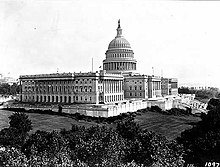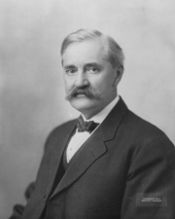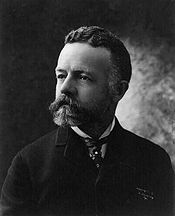68th United States Congress: Difference between revisions
Rescuing 1 sources and tagging 0 as dead. #IABot (v1.2.4) |
|||
| Line 1,376: | Line 1,376: | ||
==External links== |
==External links== |
||
*[http://www.gpoaccess.gov/serialset/cdocuments/hd108-222/index.html Biographical Directory of the U.S. Congress] |
*[https://web.archive.org/web/20060601025644/http://www.gpoaccess.gov/serialset/cdocuments/hd108-222/index.html Biographical Directory of the U.S. Congress] |
||
*[http://clerk.house.gov/art_history/house_history/index.html U.S. House of Representatives: House History] |
*[http://clerk.house.gov/art_history/house_history/index.html U.S. House of Representatives: House History] |
||
*[http://www.senate.gov/pagelayout/reference/two_column_table/stats_and_lists.htm U.S. Senate: Statistics and Lists] |
*[http://www.senate.gov/pagelayout/reference/two_column_table/stats_and_lists.htm U.S. Senate: Statistics and Lists] |
||
Revision as of 09:20, 30 September 2016
This article includes a list of references, related reading, or external links, but its sources remain unclear because it lacks inline citations. (October 2015) |
| 68th United States Congress | |
|---|---|
67th ← → 69th | |
 United States Capitol (1906) | |
March 4, 1923 – March 4, 1925 | |
| Members | 96 senators 435 representatives 5 non-voting delegates |
| Senate majority | Republican |
| Senate President | Calvin Coolidge (R) (until August 2, 1923) Vacant (from August 2, 1923) |
| House majority | Republican |
| House Speaker | Frederick H. Gillett (R) |
| Sessions | |
| 1st: December 3, 1923 – June 7, 1924 2nd: December 1, 1924 – March 3, 1925 | |
The Sixty-eighth United States Congress was a meeting of the legislative branch of the United States federal government, consisting of the United States Senate and the United States House of Representatives. It met in Washington, D.C. from March 4, 1923 to March 4, 1925, during the last months of Warren G. Harding's presidency, and the first years of his successor, Calvin Coolidge. The apportionment of seats in the House of Representatives was based on the Thirteenth Decennial Census of the United States in 1910. Both chambers had a Republican majority.
Major events
- August 2, 1923 – President Warren Harding died and Calvin Coolidge became President of the United States
Major legislation
- September 22, 1923: U.S. Coal Commission Act
- April 26, 1924: Seed and Feed Loan Act
- May 19, 1924: World War Adjusted Compensation Act (Bonus Bill), Sess. 1, ch. 157, 43 Stat. 121
- May 24, 1924: Rogers Act
- May 26, 1924: Immigration Act of 1924 (Johnson–Reed Act), Sess. 1, ch. 190, 43 Stat. 153
- May 29, 1924: Indian Oil Leasing Act of 1924 (Lenroot Act)
- June 2, 1924: Indian Citizenship Act of 1924 (Snyder Act), Sess. 1, ch. 233, 43 Stat. 253
- June 2, 1924: Revenue Act of 1924 (Simmons–Longworth Act), Sess. 1, ch. 234, 43 Stat. 253
- June 3, 1924: Inland Waterways Act of 1924 (Denison Act)
- June 7, 1924: Pueblo Lands Act of 1924
- June 7, 1924: Oil Pollution Act of 1924, Pub. L. 68–238, ch. 316, 43 Stat. 604
- June 7, 1924: Clarke–McNary Act, Sess. 1, ch. 348, 43 Stat. 653
- January 30, 1925: Hoch–Smith Resolution
- January 31, 1925: Special Duties Act
- February 2, 1925: Airmail Act of 1925 (Kelly Act)
- February 12, 1925: Federal Arbitration Act
- February 16, 1925: Home Port Act of 1925
- February 24, 1925: Purnell Act
- February 27, 1925: Temple Act
- February 28, 1925: Classification Act of 1925
- February 28, 1925: Federal Corrupt Practices Act (Gerry Act)
- March 2, 1925: Judiciary Act of 1925
- March 3, 1925: River and Harbors Act of 1925
- March 3, 1925: Helium Act of 1925
- March 3, 1925: Mount Rushmore National Memorial Act (Norbeck-Williamson Act)
- March 4, 1925: Establishment of the United States Navy Band
- March 4, 1925: Probation Act of 1925
Party summary
The count below identifies party affiliations at the beginning of the first session of this Congress, and includes members from vacancies and newly admitted states, when they were first seated. Changes resulting from subsequent replacements are shown below in the "Changes in membership" section??.?%
Senate
| Party (shading shows control) |
Total | Vacant | |||
|---|---|---|---|---|---|
| Democratic (D) |
Farmer– Labor (FL) | Republican (R) |
|||
| End of previous congress | 37 | 0 | 59 | 96 | 0 |
| Begin | 42 | 1 | 53 | 96 | 0 |
| End | 2 | 52 | |||
| Final voting share | 43.8% | 2.1% | 54.2% | ||
| Beginning of next congress | 40 | 1 | 55 | 96 | 0 |
House of Representatives
| Party (Shading indicates majority caucus)
|
Total | |||||
|---|---|---|---|---|---|---|
| Republican | Democratic | Farmer–Labor | Socialist | Vacant | ||
| End of the previous Congress | 302 | 131 | 0 | 1 | 435 | 0 |
| Begin | 225 | 207 | 2 | 1 | 435 | 0 |
| End | ?? | ?? | ?? | ?? | ?? | ?? |
| Final voting share | ??.?% | ??.?% | ??.?% | ??.?% | ||
| Beginning of the next Congress | 247 | 183 | 3 | 1 | 435 | 0 |
Leadership

Senate
- President: Calvin Coolidge (R), until August 3, 1923; vacant thereafter.
- President pro tempore: Albert B. Cummins (R)
Majority (Republican) leadership
Minority (Democratic) leadership
House of Representatives
Majority (Republican) leadership
Minority (Democratic) leadership
Members
This list is arranged by chamber, then by state. Senators are listed in order of seniority, and Representatives are listed by district.
Senate


Albert B. Cummins

Henry Cabot Lodge

Joseph T. Robinson

Nicholas Longworth
Senators were elected every two years, with one-third beginning new six-year terms with each Congress. Preceding the names in the list below are Senate class numbers, which indicate the cycle of their election. In this Congress, Class 1 meant their term began in this Congress, requiring reelection in 1928; Class 2 meant their term ended with this Congress, requiring reelection in 1924; and Class 3 meant their term began in the last Congress, requiring reelection in 1926.
House of Representatives
The names of members of the House of Representatives elected statewide on the general ticket or otherwise at-large, are preceded by their district numbers.
Changes in membership
The count below reflects changes from the beginning of the first session of this Congress.
Senate
- replacements: 7
- Democratic: 1 seat net gain
- Republican: 2 seat net loss
- Farmer–Labor: 1 seat net gain
- deaths: 7
- resignations: 0
- vacancy: 0
- Total seats with changes: 8
| State | Senator | Reason for Vacancy | Successor | Date of Successor's Installation |
|---|---|---|---|---|
| Colorado (3) |
Samuel D. Nicholson (R) | Died March 24, 1923. Successor was appointed. | Alva B. Adams (D) | May 17, 1923 |
| Minnesota (2) |
Knute Nelson (R) | Died April 28, 1923. Successor was elected. | Magnus Johnson (FL) | July 16, 1923 |
| Vermont (3) |
William P. Dillingham (R) | Died July 12, 1923. Successor was elected. | Porter H. Dale (R) | November 7, 1923 |
| Rhode Island (2) |
LeBaron Bradford Colt (R) | Died August 18, 1924. Successor was elected. | Jesse H. Metcalf (R) | November 5, 1924 |
| Connecticut (3) |
Frank B. Brandegee (R) | Died October 14, 1924. Successor was elected. | Hiram Bingham III (R) | December 17, 1924 |
| Massachusetts (1) |
Henry Cabot Lodge (R) | Died November 9, 1924. Successor was appointed. | William M. Butler (R) | November 13, 1924 |
| Colorado (3) |
Alva B. Adams (D) | Interim appointment. Successor was elected. Served until November 30, 1924. | Rice W. Means (R) | December 1, 1924 |
| Illinois (2) |
Joseph M. McCormick (R) | Died February 25, 1925. Successor was appointed and subsequently elected. | Charles S. Deneen (R) | February 26, 1925 |
House of Representatives
- replacements: 22
- Democratic: 1 seat net gain
- Republican: 1 seat net loss
- deaths: 15
- resignations: 6
- contested election: 0
- Total seats with changes: 24
| District | Vacator | Reason for Vacancy | Successor | |
|---|---|---|---|---|
| Illinois 2nd | Vacant | Rep. James R. Mann died during previous congress | Morton D. Hull (R) | April 3, 1923 |
| California 10th | Vacant | Rep. Henry Z. Osborne died during previous congress | John D. Fredericks (R) | May 1, 1923 |
| New York 16th | Vacant | Rep. William Bourke Cockran died during previous congress | John J. O'Connor (D) | November 6, 1923 |
| Alabama 2nd | John R. Tyson (D) | Died March 27, 1923 | Lister Hill (D) | August 14, 1923 |
| Michigan 3rd | John M. C. Smith (R) | Died March 30, 1923 | Arthur B. Williams (R) | June 19, 1923 |
| Iowa 8th | Horace M. Towner (R) | Resigned April 1, 1923 after being appointed Governor of Puerto Rico | Hiram K. Evans (R) | June 4, 1923 |
| New York 11th | Daniel J. Riordan (D) | Died April 28, 1923 | Anning S. Prall (D) | November 6, 1923 |
| Illinois 4th | John W. Rainey (D) | Died May 4, 1923 | Thomas A. Doyle (D) | November 6, 1923 |
| Arkansas 6th | Lewis E. Sawyer (D) | Died May 5, 1923 | James B. Reed (D) | October 6, 1923 |
| Washington 5th | J. Stanley Webster (R) | Resigned May 8, 1923 after being appointed to United States District Court for the Eastern District of Washington | Samuel B. Hill (D) | September 25, 1923 |
| North Carolina 2nd | Claude Kitchin (D) | Died May 31, 1923 | John H. Kerr (D) | November 6, 1923 |
| New York 32nd | Luther W. Mott (R) | Died July 10, 1923 | Thaddeus C. Sweet (R) | November 6, 1923 |
| Vermont 2nd | Porter H. Dale (R) | Resigned August 11, 1923 after becoming a candidate for the US Senate | Ernest Willard Gibson (R) | November 6, 1923 |
| Kentucky 7th | J. Campbell Cantrill (D) | Died September 2, 1923 | Joseph W. Morris (D) | November 30, 1923 |
| New York 24th | James V. Ganly (D) | Died September 7, 1923 | Benjamin L. Fairchild (R) | November 6, 1923 |
| Mississippi 3rd | Benjamin G. Humphreys II (D) | Died October 16, 1923 | William Y. Humphreys (D) | November 27, 1923 |
| Kentucky 9th | William J. Fields (D) | Resigned December 11, 1923 | Fred M. Vinson (D) | January 24, 1924 |
| Louisiana 2nd | H. Garland Dupré (D) | Died February 21, 1924 | James Z. Spearing (D) | April 22, 1924 |
| Illinois 14th | William J. Graham (R) | Resigned June 7, 1924 after being appointed to the United States Court of Customs Appeals | Seat remained vacant until next Congress | |
| Kansas 2nd | Edward C. Little (R) | Died June 27, 1924 | Ulysses S. Guyer (R) | November 4, 1924 |
| North Dakota 2nd | George M. Young (R) | Resigned September 2, 1924 after being appointed to the Board of General Appraisers | Thomas Hall (R) | November 4, 1924 |
| Massachusetts 15th | William S. Greene (R) | Died September 22, 1924 | Robert M. Leach (R) | November 4, 1924 |
| Maryland 5th | Sydney E. Mudd II (R) | Died October 11, 1924 | Stephen W. Gambrill (D) | November 4, 1924 |
| California 4th | Julius Kahn (R) | Died December 18, 1924 | Seat remained vacant until next Congress | |
Committees
Lists of committees and their party leaders.
Senate
- Agriculture and Forestry
- Attorney General Harry M. Daugherty (Select)
- Audit and Control the Contingent Expenses of the Senate
- Banking and Currency
- Campaign Expenditures (Special)
- Charges against Burton K. Wheeler (Select)
- Civil Service
- Claims
- Commerce
- District of Columbia
- Education and Labor
- Enrolled Bills
- Expenditures in Executive Departments
- Immigration
- Immigration and Naturalization
- Indian Affairs
- Internal Revenue Bureau (Select)
- Interoceanic Canals
- Interstate Commerce
- Library
- Manufactures
- Military Affairs
- Mines and Mining
- Naval Affairs
- Nine Foot Channel from the Great Lakes to the Gulf (Select)
- Patents
- Pensions
- Post Office and Post Roads
- Printing
- Privileges and Elections
- Propaganda Affecting Taxation and Soldiers' Bonus (Select)
- Public Buildings and Grounds
- Public Lands and Surveys
- Reforestation (Select)
- Revision of the Laws
- Rules
- Territories and Insular Possessions
- Veterans Bureau Investigation (Select)
- War Finance Corporation Loans (Select)
- Whole
House of Representatives
- Accounts
- Air Services (Select)
- Alcoholic Liquor Traffic
- Banking and Currency
- Census
- Civil Service
- Claims
- Coinage, Weights and Measures
- Disposition of Executive Papers
- District of Columbia
- Education
- Election of the President, Vice President and Representatives in Congress
- Elections
- Enrolled Bills
- Expenditures in the Agriculture Department
- Expenditures in the Commerce Department
- Expenditures in the Interior Department
- Expenditures in the Justice Department
- Expenditures in the Labor Department
- Expenditures in the Navy Department
- Expenditures in the Post Office Department
- Expenditures in the State Department
- Expenditures in the Treasury Department
- Expenditures in the War Department
- Expenditures on Public Buildings
- Flood Control
- Immigration and Naturalization
- Indian Affairs
- Industrial Arts and Expositions
- Insular Affairs
- Interstate and Foreign Commerce
- Whole
Joint committees
Employees
- Architect of the Capitol:
- Elliott Woods, until May 22, 1923
- David Lynn, from August 22, 1923
- Comptroller General of the United States: John R. McCarl
- Librarian of Congress: Herbert Putnam
- Public Printer of the United States: George H. Carter
Senate
- Chaplain: John J. Muir Baptist
- Secretary: George A. Sanderson of Illinois
- Sergeant at Arms: David S. Barry of Rhode Island
House of Representatives
- Chaplain: James S. Montgomery Methodist, elected April 11, 1921
- Clerk: William T. Page of Maryland, elected December 5, 1923
- Doorkeeper: Bert W. Kennedy of Michigan, elected December 5, 1923
- Clerk at the Speaker’s Table: Lehr Fess
- Postmaster of the House: Frank W. Collier of Wisconsin, elected December 5, 1923
- Sergeant at Arms: Joseph G. Rodgers of Pennsylvania, elected December 5, 1923
See also
- United States elections, 1922 (elections leading to this Congress)
- United States elections, 1924 (elections during this Congress, leading to the next Congress)
References
- Martis, Kenneth C. (1989). The Historical Atlas of Political Parties in the United States Congress. New York: Macmillan Publishing Company.
{{cite book}}: Cite has empty unknown parameter:|coauthors=(help) - Martis, Kenneth C. (1982). The Historical Atlas of United States Congressional Districts. New York: Macmillan Publishing Company.
{{cite book}}: Cite has empty unknown parameter:|coauthors=(help)
External links
- Biographical Directory of the U.S. Congress
- U.S. House of Representatives: House History
- U.S. Senate: Statistics and Lists
- Official Congressional Directory for the 68th Congress, 1st Session.
- Official Congressional Directory for the 68th Congress, 1st Session (Revision).
- Official Congressional Directory for the 68th Congress, 2nd Session.
- Official Congressional Directory for the 68th Congress, 2nd Session (1st Revision).
- Official Congressional Directory for the 68th Congress, 2nd Session (2nd Revision).

